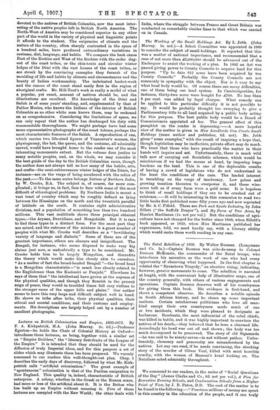SOME BOOKS OF THE WEEK.
[Under this hooding we notice incoh Books of the seek as have sot been reserved for review in other form.] In the series of "Native Races of the Empire" (A. Constable and Co., 65. net) we have The Natives of British North America, the Sash and Dine, by C. Hill-Tout This volume is devoted to the natives of British Columbia, now the most inter- esting of the native peoples left in British North America. The North-West of America may be considered superior to any other part of the world in the variety of physical and linguistic points it affords to the student. The exigencies of climate and the nature of the country, often sharply contrasted in the space of a hundred miles, have produced extraordinary variations in costume, diet, language, and habits. We compare the bark canoe East of the Rockies and West of the Rockies with the cedar dug- out of the coast tribes, or the skin-tents and circular winter lodges of the Dene with the vast houses of the coast tribes, or are struck by the convincing examples they furnish of the moulding of life and habits by climate and circumstances and the beauty of Indian workmanship. The imbricated basket-work and the canoes of the coast stand easily first in the region of aboriginal crafts. Mr. Hill-Tout's work is really a model of what a popular, yet exact, account of natives should be, and the illustrations are excellent. His knowledge of the Dene and Salish is of some years' standing, and, supplemented by that of Father Morice, who knows the Indians of the interior of British Columbia as no other white man knows them, may be reckoned on as comprehensive. Considering the limitations of space, we can only repeat that the author has discharged his duty with commendable thoroughness. We might perhaps have had some more representative photographs of the coast totems, perhaps the most characteristic features of the Salish. A reproduction of one, which carries two life-sized figures of Vancouver's seamen, the physiognomy, the hat, the queue, and the costume, all admirably carved, would have brought home to the reader one of the most interesting monuments extant. But the volume does justice to many notable peoples, and, on the whole, we may consider it the best guide of the day to the British Columbian races, though the author does not always tell us how many of the habits, arts, and crafts—the semi-subterranean winter lodges of the Dina, for instance—are on the verge of being numbered with the relics of the past.—To the same series belongs Natives of Northern India, by W. Crooke, B.A. The subject is, of course, far more com- plicated ; it brings us, in fact, face to face with some of the most difficult of ethnological problems. By Northern India is meant a vast tract of country which may be roughly defined as lying between the Himalayas on the north and the twentieth parallel of latitude on the south. It contains eight administrative divisions, and a population of something less than two hundred millions. This vast multitude shows three principal ethnical types,—the Aryans, Dravidians, and Mongoloids. But it is rare to find these types in a distinct form. For the most part they are mixed, and the outcome of the mixture is a great number of peoples with what Mr. Crooke well describes as a "bewildering variety of language and dialects." Some of these are of the greatest importance, others are obscure and insignificant. The Bengali, for instance, who seems disposed to make very big claims just now, is undoubtedly a type to be considered. Mr. Crooke holds him to be largely Mongolian, and discredits the theory which would make him closely akin to ourselves. " As a matter of fact the broad-headed Bengali "—the broad head is a Mongolian characteristic—" is much less closely related to the Englishman than the Keshmiri or Punjabi." Elsewhere he says of them that "the intellectual have grown at the expense of the physical qualities, and though they flourish in the present reign of peace, they would in troubled times fall easy victims to the stronger races of the upper hills and plains." Our author seems to have this very large and difficult subject well in hand. He shows us tribe after tribe, their physical qualities, their ethical and mental conditions, and their customs and employ- ments. His descriptions are largely helped out by a number of excellent photographs.











































 Previous page
Previous page